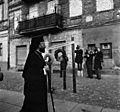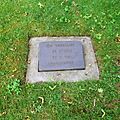Ida Siekmann facts for kids
Quick facts for kids
Ida Siekmann
|
|
|---|---|

Ida Siekmann, at the Window of Remembrance, Berlin Wall Memorial, Bernauer Straße (2011)
|
|
| Born | 23 August 1902 Gorken, West Prussia, German Empire
|
| Died | 22 August 1961 (aged 58) |
| Cause of death | Fall injuries |
| Body discovered | Bernauer Strasse 48 52°32′25″N 13°24′10″E / 52.5402°N 13.4029°E |
| Resting place | Urnenfriedhof Seestraße Berlin-Wedding |
| Monuments | "Window Of Remembrance", Berlin |
| Known for | First casualty at the Berlin Wall |
Ida Siekmann (born August 23, 1902 – died August 22, 1961) was a German nurse. She became the first known person to die at the Berlin Wall. This tragic event happened just nine days after the wall started to be built.
Contents
Who Was Ida Siekmann?
Ida Siekmann was born on August 23, 1902, in a place called Gorken, which was then part of the German Empire. Today, this area is in Poland. Later, she moved to Berlin and worked as a nurse.
By August 1961, Ida was a widow. She lived at Bernauer Straße 48 in Berlin. Her sister, Martha L., lived only a few blocks away.
Berlin Divided: East and West
After World War II, the city of Berlin was split into four parts, controlled by different countries. The street where Ida lived, Bernauer Straße, was a special place. The sidewalk and the street itself were in the French part of West Berlin. However, the buildings on the south side of the street, including Ida's apartment, were in the Soviet part of East Berlin.
This meant that Ida could easily cross the border between East and West Berlin just by stepping out of her house. Her sister's home was located in West Berlin, making it easy for them to visit each other.
The Berlin Wall and Ida's Death
On August 13, 1961, East Germany began building the Berlin Wall. This wall was meant to stop people from leaving East Germany and going to West Germany. Suddenly, the border between East and West Berlin was closed. Many families living on Bernauer Straße quickly fled to the West.
Changes to Buildings on Bernauer Straße
Just five days after the wall began, on August 18, 1961, the leader of East Germany, Walter Ulbricht, gave a new order. He told the border guards to brick up the ground-floor entrances and windows of buildings on the southern side of Bernauer Straße.
People trying to enter these houses were strictly checked. Even in the hallways, residents faced tight controls. Despite this, many people living in the upper floors of these buildings still tried to escape to West Berlin. Often, the West Berlin fire department would help them by holding out large jumping sheets for them to land on safely.
Ida's Final Moments
On August 21, the East German authorities began blocking the entrance and windows of Ida Siekmann's building at Bernauer Straße 48.
The next morning, August 22, was the day before her 59th birthday. Ida threw a quilt and some of her belongings down onto the street in West Berlin. Then, she jumped from her fourth-floor apartment window. Sadly, she jumped before the firefighters could properly open their jumping sheet.
Ida was badly hurt when she hit the pavement. She died on her way to the Lazarus Hospital shortly after her fall. This made Ida Siekmann the first known person to die at the Berlin Wall.
Ida's Burial and Memorial
Ida Siekmann was buried at the Seestraße cemetery on August 29. In September, a memorial was put up at Bernauer Straße 48 to remember her. Many important visitors, like Robert F. Kennedy and Archbishop Makarios, came to this memorial to honor the people who died at the Berlin Wall.
The buildings on the southern side of Bernauer Straße, including where Ida lived, were torn down in 1963. A concrete wall was built in their place.
Images for kids
-
Makarios III, President of Cyprus, at the Siekmann memorial (1962)
See also
 In Spanish: Ida Siekmann para niños
In Spanish: Ida Siekmann para niños
- List of deaths at the Berlin Wall
- Berlin Crisis of 1961
Literature
- Hans-Hermann Hertle, Maria Nooke, The deaths at the Berlin Wall 1961–1989: a biographical handbook (ed. the Centre for Contemporary History Potsdam and the Berlin Wall Foundation). Links, Berlin 2009, ISBN: 978-3-86153-517-1, pp. 36–38





